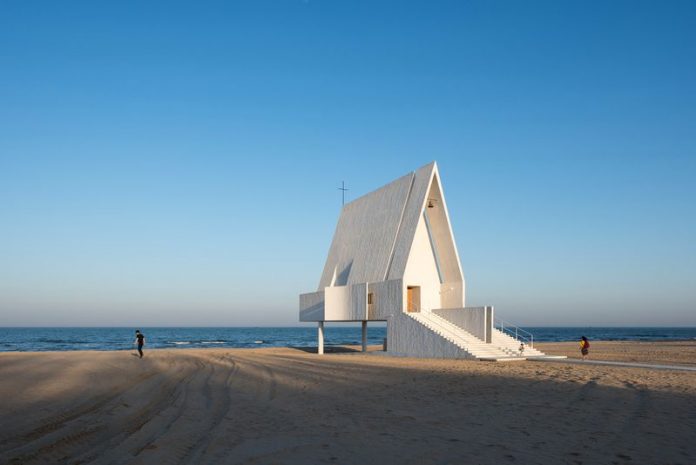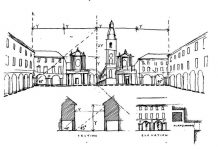A building is a ground structure that has an internal space designed
and adapted for a particular type of activity.
Requirements for buildings:
- Functional expediency – the building must meet the process
it is intended for. For each type of building, there are main and utility rooms. Each building must have a certain environment (space for activities, equipment, air temperature, lighting, etc.). - Technical feasibility – the building must reliably protect people from external influences, be durable (the building must withstand loads without destruction and large residual deformations), stable (rigid, must maintain balance under the influence of loads), durable (strength and stability over time) and fireproof (measures that reduce
the possibility of a fire in the building; fire resistance limit – the time during which the structure undergoes retains strength by the action of fire).
Impacts on buildings can be forceful (loads from the building’s own mass, equipment, people, wind action) and non-forceful (temperature effects, exposure to moisture, sun, chemicals, noise). - Architectural and artistic expressiveness – the building should be functionally convenient and technically perfect.
- Economic requirements – ensuring the strength, stability, durability of the building at an optimal cost.
Structural schemes of buildings.
- Frameless (walls and ceilings):
A) with longitudinal load-bearing walls,
B) with transverse longitudinal walls. - Frame buildings (columns, crossbars, ceilings):
A) with a longitudinal frame,
B) with a cross frame,
C) with a spatial framework. - With an incomplete frame (instead of the inner wall of the column):
A) with an incomplete longitudinal frame,
B) with an incomplete transverse frame.
Characteristics of the main elements of the building according to static operation and enclosing functions, the diagram of the building in the section or axonometry.
The foundation is an underground structure that takes the load from the building and
transfers it to the ground.
Walls – external and internal, vertical, enclosing, bearing and non-bearing elements of the building (bearing – perceive the load from the overlap, self-supporting – perceive the load from their own weight, hinged).
Individual supports are vertical load-bearing elements. Pillars, pillars, columns.
Overlaps – horizontal, load-bearing, enclosing elements.
The covering (roof) is an enclosing structure that protects the building from external influences from above. There are attic and heartless.
The staircase is a load-bearing structure that serves for connecting between floors and for
evacuation in emergency situations.
Partitions – vertical, enclosing elements installed on the floors.
Windows are structures designed to provide natural lighting and fencing.
The door is used for communication between rooms.
Foundations. Requirements, basic concepts and classification.
The base is the soil located above the sole of the foundation and perceiving the load from the building.
The base is of two types:
- Natural – soil that can withstand the load from the building, being in its natural state (rocky, coarse-grained, sandy, clay- the depth of the foundation is more frozen).
- Artificial – artificially hardened soils that in their natural state do not have sufficient bearing capacity (loess, bulk, alluvial, quicksand).
Requirements for the grounds:
- Strength – must have sufficient bearing capacity, as well as low and uniform compressibility.
- They should not be heaving, i.e. they should not increase in volume when moisture freezes in the pores of the soil.
- Should not be eroded and dissolved by groundwater.
- Should not allow subsidence and landslides.
The foundation is an underground structural element that perceives the load from the building and transfers it to the base.
Requirements for foundations: strength, stability, durability, economy.
Classification of foundations:
- According to the constructive form: ribbon (under the wall tapes), columnar (under
the frame), pile (good soil deep), solid (under heavy loads). - By the nature of the work: rigid (for compression), flexible (for bending).
- By material: concrete (for compression), w/ b (for bending), rubble (for compression),
rubble concrete, made of solid brick. - According to the shape of the cross section: rectangular foundation, stepped.
- According to the method of the device: monolithic, prefabricated.
Ribbon foundations. Their classification, section.
They are installed under the wall tapes. They can be prefabricated and monolithic.
The most widely used are prefabricated tape foundations, which are made of:
- Prefabricated W/W foundation slabs (F), height 300-500, width 600-3200 with 2M,
length 2400 or 1200. - Concrete blocks of basement walls (FBS), height 600, width 300, 400, 500, 600,
length 2400 or 1200.
Foundation slabs are laid on the ground of the base, if it is sandy soils, otherwise sand, crushed stone or gravel, 100 mm thick, are laid under the foundations.
The plates are laid either with a solid tape or with breaks.
Foundation blocks are laid on slabs on a layer of cement-sand mortar in 1-5 rows.
Cement-sand mortar is also poured into the seams between the blocks. The blocks
are stacked with mandatory dressing.
At the intersection of the walls on the top of the foundation slabs, a reinforcing mesh is installed to ensure greater rigidity of the building.
When building on slopes, in order to save money, the foundations are laid in steps.
Columnar, solid, pile foundations. Classification, cross sections.
Columnar. They are erected under columns in high – rise buildings with a foundation depth of 4-5 m . They are arranged with small loads on the foundation of rubble, rubble concrete, W / B. Under the walls – a foundation beam.
The distance between the axes of the foundation pillars is taken from 2.5 to 3 m, and if
the soils are strong, then up to 6 m. The pillars are placed at the corners of the building, at the intersection and junction of the walls and under the piers. The cross-section must be at least 0.4 m.
The pillars are covered with railway beams. Under the foundations, a sand filling
with a thickness of 0.5-0.6 m is made.
Columnar foundations are monolithic (b) and prefabricated (c, d).
Walls. Requirements, classifications. Brick walls, types of masonry, nodes.
Walls are the enclosing, load-bearing or self-supporting element of a building.
Requirements for walls: strength, stability, durability, compliance with
the degree of fire resistance, maintenance of temperature and humidity conditions in
the room, possession of sound insulation properties, manufacturability in
the device (industriality), economy, architectural and artistic
expressiveness.
Classification of walls: 1) By material: Stone, Wood, Multilayer
(stone, insulation, outer layer). 2) By the nature of the work: Load-bearing,
Self-supporting, Hinged. 3) According to the device method: Of small-sized elements –
manually, Machine-made for large-sized elements, Monolithic. 4) By
location: External, Internal.
The strength of the brickwork depends on: the strength of the brick, the strength of the mortar,
the type of masonry. Solid masonry: single-row (chain; stronger, more
labor-intensive), double-row (less labor-intensive, less durable). Types of stitches:
triangle, convex roller, convex, in pruning, in a hollow. Vertical
seam – 10mm, horizontal – 12mm.
Architectural and structural details of stone walls. Jumpers, cross-section selection.
Cornice – horizontal profiled protrusions of walls designed to divert
water falling on the building’s enclosing structures.
Cornices are divided into: 1) Crowning (main) – located on top of the wall. From W/W
cantilever slabs or by releasing several rows of bricks. 2) The intermediate
cornice, which has a smaller outflow, is arranged at the level of the interstitial floors.
3) Belt – under window and door openings. 4) Sandrik – above the openings of windows and doors, made of prefabricated blocks.
The basement is the lower part of the wall located directly above the foundation.
The basement protects the building from precipitation and mechanical damage. It is made of strong, resistant, durable materials (concrete foundation blocks; bricks
plastered with cement mortar; natural stones). The top of the basement is located at the level of the 1st floor.
Pilasters are vertical thickening of walls of rectangular cross-section, serving to strengthen the walls and increase their stability.
Semi-columns are semicircular projections.
Buttress is a thickening of the wall with an inclined front face, which increases the stability
of the walls from the effects of horizontal forces.
A niche is a shallow recess for placing various equipment.
Deformation seams. They are arranged to avoid the appearance of cracks in the walls of buildings from uneven precipitation and as a result of deformation of the material during
temperature fluctuations.
Sedimentary seams are arranged in the case of different storeys of parts of the building – the seam cuts the building completely into compartments that can work independently under load.
Temperature seams cut the wall from the top to the foundation, dividing it into
separate compartments.
The balcony is a load-bearing structure, in the form of a plate pinched in the wall.
Loggia is a terrace built into the dimensions of the building, open on the front side and
fenced on the other three sides with capital walls.
A bay window is a part of a room enclosed by external walls, protruding beyond the outer
plane of the facade wall, illuminated by windows.
A lintel is a structure that covers openings in the walls and supports the upper part of the wall. They perceive their own load and the load from the upstream wall and transmit it to the downstream wall elements.
W / B, (B, BU, PP (plate)), reinforced brick (reinforcement steel frames are laid), wedge-shaped flat and arched (labor-intensive). The brand depends on the length and width of the opening.
Windows and doors, requirements, classification, elements, sections.
A window is a vertical enclosing structure designed for natural lighting of the room.
Requirements: heat-protective and sound-insulating properties, light transmittance,
manufacturability in the device (industriality), economy, architectural and artistic expressiveness.
Classification: by material (wooden, metal, plastic), by the method of opening (casement, blind, sliding, overhead, lower-hinged, louvered, etc.), by the number of glasses (single (southern regions), double (temperate climate), triple glazing (harsh climate)).
H is 1100-1300mm less than the height of the floor.
Window blocks consist of: window boxes (frame, upper part – transom; separate and shared), glazed bindings, window sills.
The door is a vertical structure designed for communication between rooms.
They consist of boxes (frames fixed in doorways of walls) or partitions and
canvases hung on door frames.
Classification: by the number of canvases (one- and two-floor and one-and-a-half), by
location (internal, external, cabinet, by design solution (panel – solid frame; panel – with strapping), according to the method of opening (swing, sliding, rotating, swinging, folding).
h 2000 and 2300mm
Large-block buildings.
Buildings whose walls are built of blocks, and the remaining elements are made of
large-sized elements.
The material is lightweight concrete. The main form of the blocks is a parallelepiped.
Wall cutting schemes: two-row, four-row (3 wall blocks).
Types of blocks: wall (h=2180, a=990-1790(M200)), bridge (h=580,
a=1980-3180(M400)), window sill (h=840, a=990-1990).
Blocks are stacked on top of each other on a layer of c / p r-ra 10-20 mm. Vertical joints:
open (wall) and closed (internal walls and lintel blocks).
21. Large-panel buildings.
Buildings mounted from pre-fabricated large-sized planar
elements.
According to the design scheme: frameless (with longitudinal and transverse walls),
frame.



















